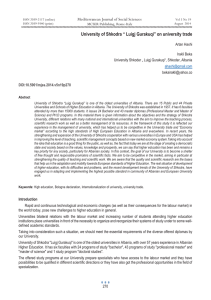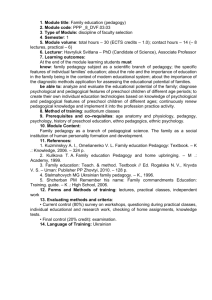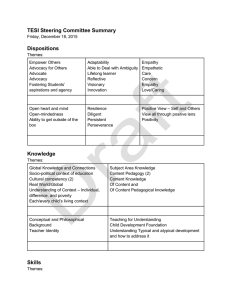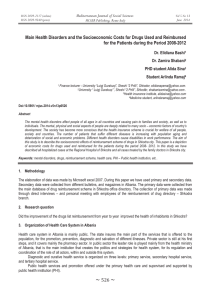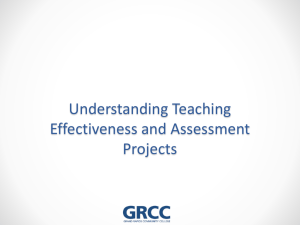Formal Rates of Herbart - Impact, Value and their Actuality
advertisement
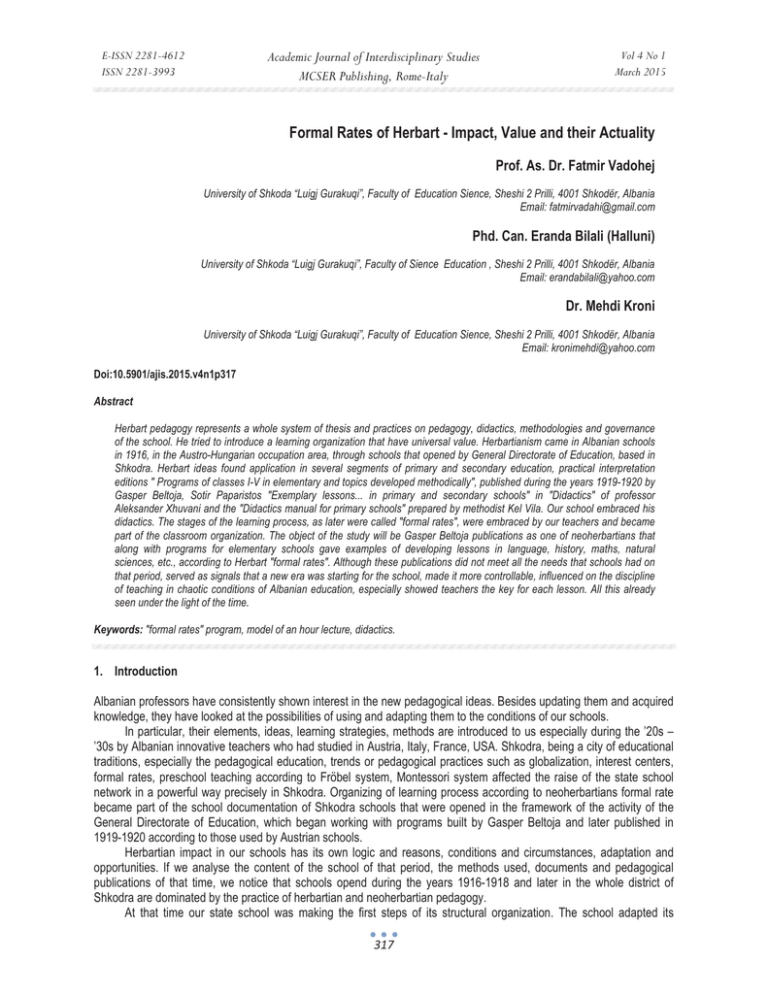
Academic Journal of Interdisciplinary Studies MCSER Publishing, Rome-Italy E-ISSN 2281-4612 ISSN 2281-3993 Vol 4 No 1 March 2015 Formal Rates of Herbart - Impact, Value and their Actuality Prof. As. Dr. Fatmir Vadohej University of Shkoda “Luigj Gurakuqi”, Faculty of Education Sience, Sheshi 2 Prilli, 4001 Shkodër, Albania Email: fatmirvadahi@gmail.com Phd. Can. Eranda Bilali (Halluni) University of Shkoda “Luigj Gurakuqi”, Faculty of Sience Education , Sheshi 2 Prilli, 4001 Shkodër, Albania Email: erandabilali@yahoo.com Dr. Mehdi Kroni University of Shkoda “Luigj Gurakuqi”, Faculty of Education Sience, Sheshi 2 Prilli, 4001 Shkodër, Albania Email: kronimehdi@yahoo.com Doi:10.5901/ajis.2015.v4n1p317 Abstract Herbart pedagogy represents a whole system of thesis and practices on pedagogy, didactics, methodologies and governance of the school. He tried to introduce a learning organization that have universal value. Herbartianism came in Albanian schools in 1916, in the Austro-Hungarian occupation area, through schools that opened by General Directorate of Education, based in Shkodra. Herbart ideas found application in several segments of primary and secondary education, practical interpretation editions " Programs of classes I-V in elementary and topics developed methodically", published during the years 1919-1920 by Gasper Beltoja, Sotir Paparistos "Exemplary lessons... in primary and secondary schools" in "Didactics" of professor Aleksander Xhuvani and the "Didactics manual for primary schools" prepared by methodist Kel Vila. Our school embraced his didactics. The stages of the learning process, as later were called "formal rates", were embraced by our teachers and became part of the classroom organization. The object of the study will be Gasper Beltoja publications as one of neoherbartians that along with programs for elementary schools gave examples of developing lessons in language, history, maths, natural sciences, etc., according to Herbart "formal rates". Although these publications did not meet all the needs that schools had on that period, served as signals that a new era was starting for the school, made it more controllable, influenced on the discipline of teaching in chaotic conditions of Albanian education, especially showed teachers the key for each lesson. All this already seen under the light of the time. Keywords: "formal rates" program, model of an hour lecture, didactics. 1. Introduction Albanian professors have consistently shown interest in the new pedagogical ideas. Besides updating them and acquired knowledge, they have looked at the possibilities of using and adapting them to the conditions of our schools. In particular, their elements, ideas, learning strategies, methods are introduced to us especially during the ’20s – ’30s by Albanian innovative teachers who had studied in Austria, Italy, France, USA. Shkodra, being a city of educational traditions, especially the pedagogical education, trends or pedagogical practices such as globalization, interest centers, formal rates, preschool teaching according to Fröbel system, Montessori system affected the raise of the state school network in a powerful way precisely in Shkodra. Organizing of learning process according to neoherbartians formal rate became part of the school documentation of Shkodra schools that were opened in the framework of the activity of the General Directorate of Education, which began working with programs built by Gasper Beltoja and later published in 1919-1920 according to those used by Austrian schools. Herbartian impact in our schools has its own logic and reasons, conditions and circumstances, adaptation and opportunities. If we analyse the content of the school of that period, the methods used, documents and pedagogical publications of that time, we notice that schools opend during the years 1916-1918 and later in the whole district of Shkodra are dominated by the practice of herbartian and neoherbartian pedagogy. At that time our state school was making the first steps of its structural organization. The school adapted its 317 E-ISSN 2281-4612 ISSN 2281-3993 Academic Journal of Interdisciplinary Studies MCSER Publishing, Rome-Italy Vol 4 No 1 March 2015 didactics by Herbart, as from its whole it adopted the so-called "formal rete" which tried to adapt its didactic documentation upon awakening of interest and the development of human capabilities according to this great pedagogue. In this article we feel the need to say something to Grandmaster Herbart (1776-1841)1. His pedagogy for the truth sake of the was not confined within the borders of Shkodra, but was widened in whole country, not only during the years 1916-1939, but even after years of World War II, although changed the label2.(Osmani, Sh 2000) 1.1 Who was J. H. Herbart? .F. Herbart was one of the most prominent personalities of the last century not only in Germany but also on the world stage as a philosopher, psychologist, professor and moralist. His pedagogy can’t be conceived outside his philosophy. A historian of world pedagogical thought cites an aphorism of Herbart "human value is not measured by what you know, but what you want to know". According to Herbart the moral culture, on the basis the will is formed is more important than intellectual culture, because it is the source of knowledge. Education is not worth if it does not have goals. In these ideas our teachers found inspiration. The Herbartism was created based on his philosophical, pedagogical, psychological and ethical ideas on the science of education for the recognition of the human spirit. His followers, applying and elaborating these ideas in new conditions, went further and took the name neoherbartian. Representatives of these ideas were also in many other countries like Switzerland, France, England and the USA, etc. Although his pedagogy represents a whole system of thesis and pedagogical practices, didactic and methodical, programming, our school took from her practical side. Programs and methodologies based on this theory are well adapted our times and conditions. He tried to introduce such a learning organization that have universal value. He determined four formal scales through which must undergo each lesson: clarity, association, system and method. Our school embraced these formal scales and tried to adapt its didactic documentation. 1.2 How was herbartian practice of pedagogy spread in Albania? The practice of herbartian pedagogy was ready applied according to the processing of German-Austrian schools had done mainly in organizing the learning process, prepared by neoherbartians. The practice of herbartian pedagogy came to Albania in three ways: • It came through primary education programs adapted by Austrian School, where herbartian principles prevailed, programs published by Gasper Beltoja. • It came through the Albanian teachers, who had made pedagogical studies in Klagenfurt and other AustroHungarian schools. • It came through the popularization which our normal3 schools made for some time, especially normal school of Elbasan. This practice came in Albanian schools in 1916, through schools that opened General Directorate of Education, based in Shkodra. Particularly it took the final form during 1919-1920 with the publication of programs for Grades I-V by Gasper Beltoja. It took shape with the introduction of the formal learning scale process: clarity, socializing, system and method. Formal scales, or as it later will be called stages of the learning process took different names, adapting neoherbartian hub. They were mostly labeled by our teachers with the following terms: preparation, goal, introdution, sumary, exercise in contain itself the basic requirements set out by the Herbart method. 1.3 Gasper Beltoja (1871-1947), life and works Gasper Beltoja was a patriot, activist of national education, passionate teacher, manager and organizer of education, J.F.Herbart: The voice of vocabulary Pedagogy, pg. 254-257. Osmani, Sh (2000) "Herbartism" and schools opened by the Department of Education in Shkodra during 1916-1920, third international seminar "Shkodra in Centuries", volume II, Shkodra, pg.416 3 Normal school – high pedagogical school. 1 2 318 E-ISSN 2281-4612 ISSN 2281-3993 Academic Journal of Interdisciplinary Studies MCSER Publishing, Rome-Italy Vol 4 No 1 March 2015 productive author, with his work and personality played a an importand role in the educational and pedagogical development of our country in more than 35 years of active and creative work. He was born in Shkodra, on 12 June 1871. He finished primary and lower secondary school in his hometown. He went to study in Austria in 1899, where he completed Klagenfurt normal school, which has been an important center of preparation of teachers in the twentieth century. Initially he worked in Skopje and from 1907-1916 served in the Franciscan College. It is worth mentioning on appointing Gjergj Fishta director of the franceskan school in 1902, made many changes in its content and organization, strengthened the national spirit of the school content, established Albanian language in all subjects and "...employed Albanian teacher, created the group of civilian teachers who along with teaching raised the national feeling to kids … ". In the group of teachers who were brought by Gjergj Fishta was Gasper Beltoja. He Directed the Directorate of Education (1918-1919) and Shkodra normal school (1919-1920). With interest is his activity of almost 10 years of Albanian-American technical high school in Tirana, known as Fultz school. Monography published in 1981 by the daughter of Harry Fultz, Johan Fultz-Konstos on the history of technical school in Tirana, highlights the great work of Gasper Beltoja and special role in ensuring the success of this school, especially normal branch its. "... Gasper Beltoja started work as a new teacher in 1922-23, who quickly adapted Hollingshed model."4 Hollingshed was the master of American active learning methods. He worked here until 1933. Technical School had also normal branch in which Gasper Beltoja developed all his professional subjects, psychology, pedagogy, methodology, history of education and citizenship lessons. Nearby was established a training school with four classes where students of normal branch performed teaching practice5(Fultz J. – Konstos 1995). Fultz daughter mention three main managin pillars of school: Director and vice director, who were Americans and Gasper Beltoja. She writes that "... the third pillar of the school, Mr. Gasper Beltoja possessed the spirit of a pioneer and served on the development of the seminars on civil rights, as well as in the preparation of the teacher for what was graduated in Vienna"6 (Fultz J. –Konstos 1995) Ernest Swift, one of the managers of the American Red Cross, after getting acquainted with Beltoja’s work, on the report dated March 1, 1923, called him an "excellent teacher". The period from 1916-17 to 1922, a very rich period in managerial and organizational activities of education and rich enough with pedagogical, scientific and methodical creativity. In this period he realized most of his school publications. Gasper Beltoja is the author of methodical-pedagogical works: "Morality breeze" (1912), "Third Book of Albanian primary schools" (1912) and " First book or ABC for Albanian elementary schools" (1921), "Theoritical pedagogy for primary school teachers and students of normal schools" (1920), "The Science and art in teaching", vol I, based on "The science and the art of teaching from Daniel Wolford", Tirana 1932. Translated and adapted even some pedagogical works of the time7.(Osmani, Sh 2008) According to prof. Vehbi Hoti, Gasper Beltoja is among the most productive author of the time. Alltogether they constitute 873 press pages8.(Hoti, V 2001) The purpose of these works is clearly stated by the author: "training of teachers, improving teaching and education". In his pedagogical work, Gasper Beltoja was guided by contemporary concepts, modern of teaching role, the education and school work. He regarded education and learning as a permanent and eternal category of human society because people never stop studying, "but they continue learning untill the last days of their lives, reading books, notebooks, asking other people for those things they do not know"9.(Bashkimi, 1910) He demanded that our school to be raised on modern and scientific bases for "To prepare people for modern life we should - wrote Beltoja – that school to be itself modern, modern life is established at work and education at school"10(Beltoja, G 1932) He worked at a time when laying the foundations of education, intellectuals, teachers had to open schools, as well as organizing its content, designing new curricula in line with national targets. Education needed programs and pedagogical literature, methodical, publications, training. Many schools were opened in Shkodra at the beginning of the State central archive, Tirana. See Fund 295, 1917 (File 1,4,6,13,18,), 1918 (file 1/1, 50), 1921 (File 17). Fultz J. –Konstos (1995) Black eagle cross, bibliography American Albanian Tirana technical school, Tirana, page 23 6 Same place, pg. 165 7 Academy of Sciences of Albania, " Albanian Encyclopedic Dictionary ", Tirana, 2008, pg.206 (Shefik Osmani). 8 Hoti, V (2001), "Gasper Beltoja and his educational and pedagogical work" Scientific Bulletin, XXXI, 1 (49), 1997-2001, Shkodra, pg.123 9 The article "Despotism is destruction of the people", the newspaper "Bashkimi", year 2, 13 March 1910. 10 Gasper Beltoja "Citizenship lessons", Tirana 1932, pg. 8 4 5 319 E-ISSN 2281-4612 ISSN 2281-3993 Academic Journal of Interdisciplinary Studies MCSER Publishing, Rome-Italy Vol 4 No 1 March 2015 second decade of the twentieth century. Thus the number of schools in the academic year 1916-1917 in the Austrian occupation area reached to 231, while the teachers 294 11 (ISP, 1990). This rapid opening of schools brought the necessity of compilation of programs, texts, etc. In these efforts Gasper Beltoja role is obvious. Programs compiled by him were taken from the Austrian models. They are analytical and directed to teachers of five classes at albanian elementary schools: "Program of the first and the second primary class", 1919 "Program of the third and the fourth primary class", 1920 "Program of the fifth primary class", 1920 He will be congratulated for the work done by the highest authorities of education. In a letter send to Beltoja by Minister of Education on 18.IV.1920, "... he congratulates him for the publication of primary education program, for the service made to homeland with the publication of these pograms in education branches ..."12(1920) 11 12 ISP, (1990) "History of Albanian education", Tirana, pg. 271. Historical Museum of Shkodra, File of education. 320 E-ISSN 2281-4612 ISSN 2281-3993 Academic Journal of Interdisciplinary Studies MCSER Publishing, Rome-Italy Vol 4 No 1 March 2015 At the Museum of Shkodra was found another letter, sent by Beltoja to Minister of Education, Sotir Peci, for the completion of the analytical program for grade III and IV.13(1920) In many publications, especially in programs and methodologies, Gasper Beltoja generalized his experience as a teacher to help the unqualified youth. In the publication " The I-st and II-nd class program of elementary school, its division developed methodicaly in several topics, "Publishing house of education, Shkodra 1919. In his introduction of the publication he say: " ... these examples developed methodicaly, will be very useful for teachers to manage better the teaching process, because in this way can be given and other topics, which are found on the divided program". Having the European experience and "trying for many years numerous methodological procedures, tracking this performance was very successful for us and gave its fruit, so my will is driven for the development of Albanian education, that’s why I am introducing my colleagues my experience, hopefully they will put them in practice if they see it necessary”14(Beltoja, G 1919). Neither he gives ready recipes, nor he requires to template them, he gives as a guidance to teachers who need to make a creative work. “In didactic field there are differences not only between nations - writes Beltoja - but also among teachers of a nation because it is wider and leaves enough free space for teachers to act."15.(Beltoja, G 1919) Gasper Beltoja, the proponent of herbartian pedagogy in those years16(Osmani, Sh 1997), launched by the needs to help methodically teachers in the teaching process gave examples of developing lessons that included curriculum subjects such as languages, history, math, natural sciences, breaking them in a practical way. 2. A Teaching Class by Gasper Beltoja Class: V Topic: Natural history Methodical units: as trees retain fruit and seeds. Ranking 1. COOKING: Talking about plants 2. PURPOSE: Today, children, we will see how the plants preserve fruit and seed. 3. PRESENTATION : a. The dressing of fruit with leaves. b. The dressing of fruit with thorns. c. The dressing of fruit with meat. d. The dressing of fruit with light bulbs. 4. SUMMARY: Focusing on subject 5. EXERCISE knowledge gained after ranking points knowledge gained explained by pupils Table How plants preserve the fruit and seed Ranking Apples, pears, etc., keep the flowers of fruit from the cold by wraping at the start with skin. Chestnuts protect the spring fruit from birds by covering it with thorns. Peaches, plums etc. preserve the spring fruit by covering it with sour pulp. Tobacco, etc. protect spring seeds putting inside the bulb wrapped with a strong leaf. Besides class phases: cooking, goal, shown, summerised exercise, as well as finalised table, which summarizes knowledge by concrete examples, another aid for the teachers is the development in details of the class. The uniqueness of the class is the way of the class development through dialogue and concretization. Historical Museum of Shkodra, File of Education. Beltoja, G (1919) "Program ..." Publishing house of education, Shkodra 1919, pg.1 15 Beltoja, G (1919) Introduction to "Program I and II class of primary school", Shkodra 16 Osmani, Sh (1997/2) "Two parallel lines of didactic publications Gasper Beltoja" pedagogical magazine, pg. 105-112 13 14 321 E-ISSN 2281-4612 ISSN 2281-3993 Academic Journal of Interdisciplinary Studies MCSER Publishing, Rome-Italy 322 Vol 4 No 1 March 2015 E-ISSN 2281-4612 ISSN 2281-3993 Academic Journal of Interdisciplinary Studies MCSER Publishing, Rome-Italy Vol 4 No 1 March 2015 Model classes are present even today, but the teacher is creative and uses variety of methods. Programs are analytical and they are addressed to teachers of five primary classes. School curricula appeared in them. Beltoja programs are obligatory from first to fifth grade in the following subjects: First and second class. Faith Language courses Mathematics Calligraphy (writing properly) Drawing Music PE Handicraft Third, fourth and fifth class. Faith Language courses Mathematics History and Nature knowledge Calligraphy (writing properly) History Drawing Music PE Handicraft for girls Objections and general goal are given at the beginning of the program, for each subject and class, eg "The knowledge of the motherland. General knowledge about Europe and other parts of the world. Reviews and widening of knowledge about Albania, Balkans, Europe and other parts of the world. Globe and its surface. General knowledge on education and civilization. Simple drawing of gjeographical maps"17.(Beltoja, G 1920) Expantion of educational network, making primary education obligatory, developing programs, although not fulfilling everything, but served as a signal that a new era was about to start, a new school based on the national education and its spirit was Albanian language. The content of the programs has a broader meaning of what we understand today. Programs having functional character, were accompanied with methodical instructions for the teacher. They are organically linked with each other, constituting a very useful methodology for five elementary classes. As schools developed first steps and being that the programs were in the function of curricula, which defined the physionomy of the school, their load, topics of subjects and in the meantime delivering solutions on many other issues such as methods, model teaching, etc. Elements of Beltoja 17 Beltoja, G (1920) "Program for grade V ..", Shkodra, pg. 7. 323 E-ISSN 2281-4612 ISSN 2281-3993 Academic Journal of Interdisciplinary Studies MCSER Publishing, Rome-Italy Vol 4 No 1 March 2015 program are of a high scientific and didactic standard even today. Many methods, guidelines, etc. of these programs coincide with today’s one. Gasper Beltoja’s school publications were welcomed by teachers and were assessed positively by press, because through them as written in the newspaper "Agimi": "For pupils learning will be nicer and for the teacher it will be easier."18(1921) 3. Implementation of Herbart Ideas in some Segments of Primary and Secondary Education and Practical Interpretation in Publications of the Period Herbart ideas found application in several segments of primary and secondary education and practical interpretation alongside publications of " Programs Classes I-V ..." from Gasper Beltoja in Sotir Paparistos "... exemplary lessons in primary and secondary schools" in "Didactics" of prof. Aleksander Xhuvani and the "Didaktic manual for primary schools" prepared by methodist Kel Vila. As the formal rates practice had gained a certain tradition, with the expansion in our school, there was an effort by our teachers to fit in the conditions of the school. So Aleksander Xhuvani 1926 published the text "the beginning of pedagogy to normal schools and elementary school teachers. Didactics of education", where a special part he dedicated "formal rates of education" or stages of learning. Here's how he gives us: a. Presentation or entry telling the intent. b. Presentation of the new subject. c. Purpose (summary and connection) or deepening. d. Usage and exercise. Evaluating "formal rates" by didactic, Aleksander Xhuvani writes that "the truth is that they have an undoubted value because they show teachers the right way and methodic steps that he should make in the processing of the subject and oblige teachers to prepare lessons thoroughly, to posses the subject and put it into action for the practical life. ... Formal rates should give teachers lesson views and keys to enter in each lesson, but according to subject content he can make any exeption of the formal rates". Kel Vila adopted a methodology for primary school under the neoherbartian influence and used the formal rates terminology: a. Preparation b. Presentation c. Knowledge strengthening d. Summary e. Usage In 1929, former director of Korça Lycée Sotir Papahristo published in Korça didactic manual "Exemplary Lessons ...", where the impact of neoherbartian didactics is strongly felt. The publication of this manual is evaluated in several ways: It became inspirator of herbartian pedagogy, especially the practical use on primary and secondary school. More positive was the adaptation of these rates on specific conditions that Albanian schools had on that period. He stressed that these exemplary lessons to have good results should not be implemented as "recipe". Teacher shold have initiative to develop the course. He wanted discipline on developing the class and he wanted the lesson to be controllable, which was provided by this form of work. He protected the idea that the teacher should not invent methods and rehearse with the students, but to undergo "stations" of the class, so herbartian formal rates. By opposing antiherbartians that say "formal rates stop and hinder the free action and initiative of teachers", he recommends for teachers "to base their work on the nature of teaching and to implement formal rates according to the needs and the nature of learning". 18 Magazine "Agimi", number 4, 1920 and number 9 September , 1921, pg. 208. 324 E-ISSN 2281-4612 ISSN 2281-3993 4. Academic Journal of Interdisciplinary Studies MCSER Publishing, Rome-Italy Vol 4 No 1 March 2015 Conclusion Despite denominations "formal rates" received they had many positive aspects. They influenced on the discipline of teaching process and gave teachers concrete model of its development. Impact of herbartian didactics remained for a long time even in the period of the school masivization. When school restarted to create its own new tradition, the herbartian impact gave way to new processes and methods. References Academy of Sciences of Albania, (2008) " Albanian Encyclopedic Dictionary ", Tirana, pg.206 (Shefik Osmani). Beltoja, G. (1932) "Citizenship lessons", Tirana, pg. 8 Beltoja, G. (1919) "Program ..." Publishing house of education, Shkodra , pg.1 Beltoja, G. (1919) Introduction to "Program I and II class of primary school", Shkodra, Beltoja, G. (1920) "Program for grade V ..", Shkodra, pg. 7. Herbart, J. F : The voice of vocabulary Pedagogy, pg. 254-257. Hoti, V (2001) "Gasper Beltoja and his educational and pedagogical work" Scientific Bulletin, XXXI, 1 (49), 1997-2001, Shkodra, pg.123. Historical Museum of Shkodra, File of education. ISP,(1990) "History of Albanian education", Tirana, pg. 271. Konstos Joan Fultz-(1995) Black eagle cross, bibliography American Albanian Tirana technical school, Tirana, pg. 23. Magazine "Agimi", number.4, 1920 and number 9 September, 1921, pg. 208. Osmani, Sh. (2000) "Herbartism" and schools opened by the Department of Education in Shkodra during 1916-1920, third international seminar "Shkodra in Centuries", volume II, Shkodra, pg.416. Osmani, Sh. (1997/2) "Two parallel lines of didactic publications Gasper Beltoja" pedagogical magazine, pg. 105-112. Osmani, Sh. (1983) “Dictionary of Pedagogy”, Tiranë. State central archive, Tirana. See Fund 295, 1917 (File 1,4,6,13,18,), 1918 (file 1/1, 50), 1921 (File 17). The article "Despotism is destruction of the people", the newspaper "Bashkimi", year 2, 13 March 1910. Xhuvani, A. (1926), "Beginning of Pedagogy for Normal Schools and for elementary school teachers " Elbasan. 325 E-ISSN 2281-4612 ISSN 2281-3993 Academic Journal of Interdisciplinary Studies MCSER Publishing, Rome-Italy 326 Vol 4 No 1 March 2015

